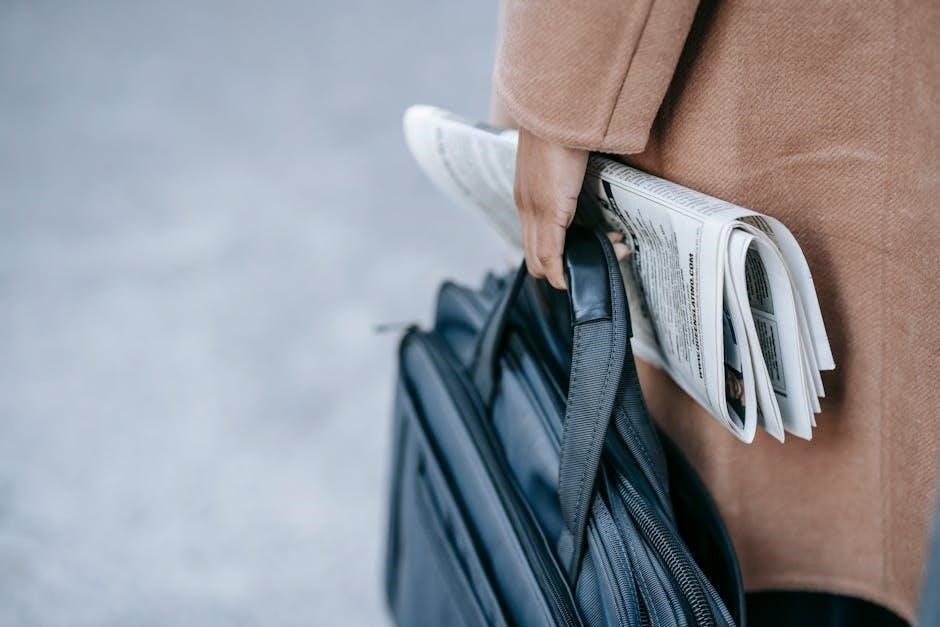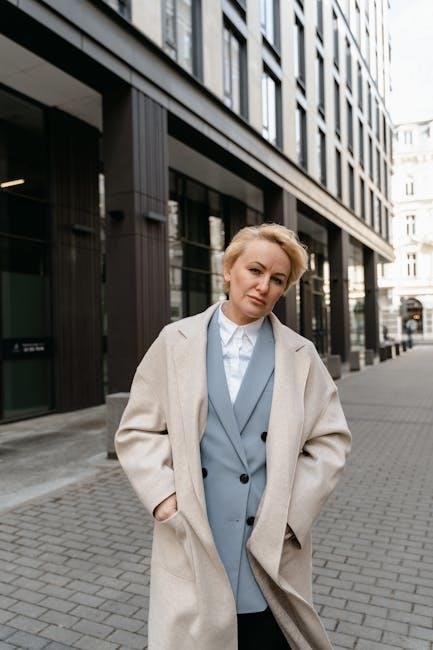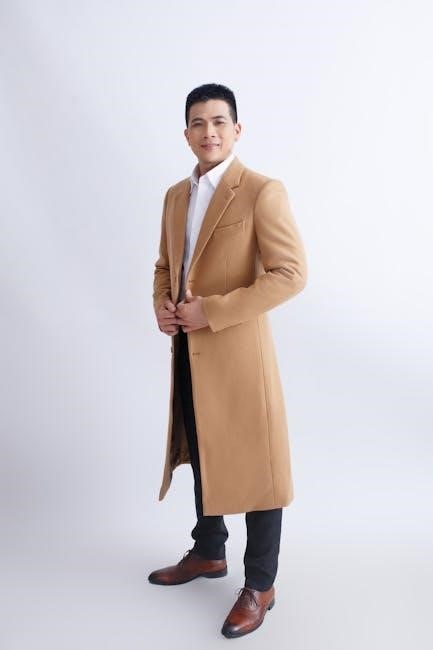Welcome to our comprehensive suit coat size guide, designed to help you find the perfect fit. Understanding measurements, styles, and fabrics ensures a tailored look that boosts confidence and professionalism, addressing common challenges like body type and personal preferences.
1.1 Importance of Proper Fit
A well-fitted suit coat is essential for both style and confidence. Proper fit ensures comfort and a polished appearance, making it a cornerstone of professional and formal attire. An ill-fitting coat can look unflattering and uncomfortable, detracting from its intended elegance. Understanding the importance of proper fit helps in selecting a coat that complements your body type, ensuring a sharp, put-together look. A good fit enhances posture, balances proportions, and creates a seamless silhouette, making it a critical factor in choosing the right suit coat. It’s not just about measurements; it’s about how the coat makes you feel and present yourself.
1.2 Understanding Suit Coat Measurements

Mastering suit coat measurements is key to achieving the perfect fit. The process involves measuring your chest, shoulders, sleeves, and coat length. Chest measurement is taken around the fullest part of your torso, ensuring the coat buttons comfortably. Shoulder fit is crucial, as it should align with your natural shoulder line. Sleeve length should reach the base of your shirt cuff, while coat length should proportional to your height and body type. Accurate measurements ensure a tailored look, avoiding both a too-tight or overly loose fit. Understanding these elements helps in selecting a coat that flatters your frame and meets your style needs.

Understanding Suit Coat Measurements

Understanding suit coat measurements involves assessing chest size, shoulder fit, sleeve length, and coat length to ensure a tailored and comfortable fit, enhancing overall appearance.
2.1 Chest Measurement
The chest measurement is a critical factor in determining suit coat size. To measure accurately, wrap a flexible tape measure around the widest part of your chest, keeping it level and parallel to the floor. Ensure the tape is snug but not overly tight, as this can restrict movement. The measurement should be taken over a dress shirt, as this provides a true reflection of your torso size. A well-fitted suit coat should allow for a full range of motion while maintaining a streamlined appearance. Proper chest measurement ensures the coat sits comfortably, avoiding both a too-tight and overly loose fit, which can compromise both style and functionality.
2.2 Shoulder Fit
Shoulder fit is essential for a suit coat, as it determines the jacket’s overall structure and appearance. The shoulder pads should align with your natural shoulder line, ensuring a seamless fit. To measure, stand straight and place your hands on your hips; the edge of the shoulder pad should not extend beyond your shoulder. If the pad is too far down, the jacket will look oversized, while pads that sit too high can restrict movement. Proper shoulder fit ensures the coat drapes naturally, creating a balanced and polished look. Ill-fitting shoulders can ruin the entire silhouette, making it crucial to prioritize this measurement for a tailored finish.
2.3 Sleeve Length
Sleeve length is a critical factor in achieving a well-fitted suit coat. The sleeves should reach the base of your thumb to ensure proper proportion and functionality. When standing naturally, the shirt cuffs should be visible, with about 1/4 to 1/2 inch exposed. To measure accurately, place your arm slightly bent at your side and measure from the center back of your neck to your wrist. Ill-fitting sleeves, whether too long or too short, can disrupt the jacket’s balance. Proper sleeve length ensures a polished appearance, complementing the overall tailored look and maintaining comfort during movement.

2.4 Body Style and Fit
Body style and fit significantly influence the comfort and aesthetics of a suit coat. Common styles include slim-fit, classic, and tailored. Slim-fit jackets are more streamlined, suitable for lean body types, while classic styles offer a traditional, relaxed fit. Tailored fits combine elements of both, offering a balanced look. The jacket should lie flat on the shoulders, with no pulling or sagging. Proper fit ensures freedom of movement and a polished appearance. Chest, waist, and shoulder measurements guide the selection, ensuring the coat complements your physique. Fabric weight and construction also play a role in achieving the desired fit and comfort.
Factors Influencing Suit Coat Size
Body type, fabric weight, padding, and personal style significantly impact suit coat sizing. These factors ensure a tailored fit that balances comfort and aesthetics for all body types.
3.1 Body Type
Your body type plays a crucial role in determining the ideal suit coat size. Slim builds require tailored fits to avoid excess fabric, while athletic or broader frames benefit from structured styles. Body type influences how measurements translate into sizing, ensuring comfort and a polished appearance. For example, a muscular torso may need a slightly larger chest measurement, while a slimmer frame can opt for a more fitted silhouette. Understanding your body type helps tailor the suit coat to flatter your proportions, creating a balanced and confident look.
3.2 Fabric and Weight
Fabric and weight significantly impact suit coat size and comfort. Heavier fabrics, like wool, provide structure and durability, while lighter options, such as linen or cotton, offer breathability. Seasonal considerations also play a role—thicker fabrics for winter and lighter ones for summer. The weight of the fabric affects how it drapes on the body, influencing the overall fit. Ensuring the fabric aligns with your lifestyle and climate is crucial for both aesthetics and functionality. Lighter fabrics may require slightly tailored fits to avoid appearing boxy, while heavier fabrics can add depth to slimmer frames, creating a balanced silhouette. This ensures optimal comfort and style.
3.3 Padding and Construction
Padding and construction play a pivotal role in shaping the suit coat’s appearance and comfort. Shoulder padding, for instance, can create a broader silhouette, while chest padding enhances definition. The level of padding varies across styles, from slim-fit to classic cuts, catering to different body types and preferences. Construction elements like double or single-breasted designs also influence the fit and durability. Proper padding ensures a balanced look, preventing the coat from appearing too tight or loose. Additionally, the stitching and seam quality impact both the coat’s longevity and its ability to maintain shape over time, ensuring a polished and professional finish.

3.4 Personal Style Preferences
Personal style preferences significantly influence suit coat size choices, as they determine the aesthetic and comfort of the garment. Some individuals prefer a slim-fit coat for a modern, streamlined look, while others opt for a classic fit for a timeless appeal. Lapel style, vent options, and fabric patterns are also subjective choices that impact the overall fit. Additionally, personal preferences may prioritize ease of movement or a tailored silhouette. Balancing these preferences with accurate measurements ensures a suit coat that aligns with both individual style and physical comfort, creating a polished and confident appearance.

How to Choose the Right Suit Coat Size
To choose the right suit coat size, measure accurately, compare sizes across brands, consider seasonal fabrics, and consult a professional tailor for a perfect fit.
4.1 Measuring Yourself
To ensure a precise fit, start by measuring yourself accurately. Use a flexible tape measure to record your chest, shoulder, and sleeve length. Measure your chest around the fullest part, keeping the tape level. For shoulders, measure from one shoulder tip to the other. Sleeve length is measured from the center back of your neck to your wrist. Take measurements while wearing a lightweight shirt to ensure accuracy. Double-check your numbers to avoid errors. These measurements will guide you in selecting the right size or tailoring your suit coat for a flawless fit.
4.2 Comparing Sizes Across Brands
Suit coat sizes can vary significantly across brands due to differences in cut, fabric, and styling. Always refer to the specific brand’s size chart to ensure accuracy. Some brands may offer slim-fit, classic, or relaxed styles, which alter measurements. Use your body measurements to compare with the brand’s chart. Consider factors like fabric weight and construction, as these can impact fit. If unsure, opt for a brand with a fit that matches your body type. Reading reviews or consulting customer service can also help verify sizing accuracy before making a purchase.
4.3 Considering Seasonal Fabrics
Seasonal fabrics play a crucial role in selecting the right suit coat. For warmer weather, opt for lightweight materials like linen, cotton, or seersucker, which offer breathability and comfort. In colder months, choose heavier fabrics such as wool or cashmere for insulation and durability. The weight and texture of the fabric can affect both the fit and the overall appearance of the suit. Consider the season and occasion when choosing your suit coat to ensure it meets your comfort and style needs. This step ensures your suit remains appropriate and comfortable year-round.
4.4 Consulting a Tailor
Consulting a tailor is a key step in ensuring your suit coat fits perfectly. A professional tailor can take precise measurements, assess your body type, and recommend styles that flatter your physique. They can also guide you on fabric selection, considering factors like season and personal preference. Tailors specialize in custom alterations, ensuring sleeves, shoulders, and body fit are tailored to your exact needs. Their expertise helps avoid common sizing mistakes, providing a bespoke solution for a polished, professional look. Investing in a tailor’s advice guarantees a suit that not only fits well but also enhances your overall appearance and confidence.
Common Mistakes to Avoid
Common mistakes include ignoring shoulder fit, not measuring accurately, and selecting the wrong fabric or style for your body type, leading to an ill-fitting suit coat.
5.1 Ignoring Shoulder Fit
Shoulder fit is crucial for a polished look. Ill-fitting shoulders can make a suit coat appear too boxy or overly tight, compromising comfort and style. Ensure shoulders align naturally without restricting movement. Neglecting proper shoulder measurement often leads to an unflattering silhouette. Always check that the shoulder pads sit smoothly and don’t extend beyond your natural shoulder line. Poor shoulder fit can ruin the overall tailored appearance, making it essential to prioritize accurate measurements. Consulting a tailor can help achieve the perfect balance for a refined, professional aesthetic.
5.2 Not Considering Body Type
Neglecting your body type when selecting a suit coat size can lead to an ill-fitting garment. Different body types require tailored styles to create a balanced look. Slim individuals may prefer streamlined cuts, while broader frames benefit from classic styles with padding. Failing to account for body type can result in a coat that appears too tight or overly boxy. Understanding your body shape ensures the suit coat complements your proportions, enhancing both comfort and aesthetics. Always consider your body type to achieve a polished, professional appearance that flatters your physique.

5.3 Overlooking Fabric Weight
Failing to consider fabric weight can significantly impact the fit and appearance of a suit coat. Heavier fabrics, such as wool, offer structure and drape well on broader frames, while lighter materials, like linen, suit slimmer builds. Seasonal fabrics also play a role, with heavier weights ideal for winter and lighter ones for summer. Ignoring fabric weight can lead to a coat that feels uncomfortable or looks misshapen. Always match the fabric weight to your body type and the occasion to ensure a polished, professional look that enhances your overall style and comfort.
5.4 Neglecting Sleeve Length
Neglecting sleeve length is a common mistake that can ruin the overall fit of a suit coat. Sleeves that are too long or too short can make the jacket look ill-fitting and unprofessional. Proper sleeve length should allow the cuff to hit just above the wrist bone when arms are straight, ensuring a balanced proportion. Overly long sleeves can overwhelm the frame, while too-short sleeves may make arms appear out of proportion. Always ensure sleeve length aligns with your arm measurements and the jacket’s style to maintain a polished, tailored appearance that complements your physique and personal style.

How to Alter a Suit Coat
Altering a suit coat can enhance fit and style. Common adjustments include taking in the sides, letting out seams, or tweaking sleeve length. Professional tailoring ensures a polished look.
6.1 Taking in the Sides
Taking in the sides of a suit coat involves slimming the torso for a more fitted appearance. Start by assessing how much fabric needs removal. Carefully mark the desired seam lines on both sides. Use scissors or a seam ripper to open the existing seams, then pin and sew the new, narrower seams. Ensure the stitching is secure and even. Press the coat to maintain a professional finish. This adjustment requires precision to avoid puckering or misalignment, making it essential to work slowly and methodically.
6.2 Letting Out the Seams
Letting out the seams is a common alteration to increase the suit coat’s size. Start by carefully removing the stitching along the side seams, shoulder seams, and lining. Use a seam ripper to gently take out each stitch, working from the bottom up. Once the seams are open, press the fabric to flatten it. Allow additional fabric to be released, then reshape the coat to fit your desired measurements. Re-sew the seams with matching thread, ensuring the stitches are even and secure. This process can add up to an inch of fabric, providing a more comfortable fit without compromising the coat’s structure or style. Proper pressing after sewing ensures a professional appearance. Always test the fit before finalizing the alterations to make necessary adjustments. Tailors often use this technique to accommodate body changes or sizing preferences. It’s a reversible process, making it ideal for heritage or investment pieces. Regular maintenance can extend the coat’s lifespan, ensuring it remains a staple in your wardrobe. Attention to detail is crucial to maintain the coat’s original quality and aesthetic appeal. This method is particularly useful for those seeking a custom fit without purchasing a new suit. By carefully letting out the seams, you can achieve a tailored look that meets your specific needs. It’s a practical solution for anyone looking to refresh their wardrobe without unnecessary expenses. Proper care after alterations ensures the suit coat remains in excellent condition, ready for years of wear. This alteration is a testament to the versatility of well-made suits, offering longevity and adaptability to changing styles and preferences. The process highlights the importance of quality craftsmanship in tailoring, allowing garments to evolve with their owners. Whether for personal comfort or to update a classic piece, letting out the seams is a valuable skill in maintaining a polished wardrobe. It underscores the value of investing in timeless, well-constructed clothing that can be adapted to meet individual needs. This approach not only extends the life of the suit but also reduces the need for frequent purchases, promoting sustainability in fashion. By understanding how to let out seams, individuals can enjoy a better fit and greater confidence in their appearance. It’s a simple yet effective way to breathe new life into a cherished suit coat, ensuring it continues to serve as a cornerstone of a sophisticated wardrobe. The ability to make such alterations is a key aspect of personal style, allowing wearers to maintain a tailored look without compromise. This technique is especially beneficial for those with unique body types or specific fit preferences, offering a solution that off-the-rack suits may not provide. In conclusion, letting out the seams is a practical and effective method to achieve a customized fit, ensuring your suit coat remains both comfortable and stylish for years to come.
6.3 Adjusting Sleeve Length
Adjusting sleeve length ensures a tailored fit and comfort. Start by assessing the current length and marking the desired adjustment. For shortening, remove the sleeve buttons and carefully cut or fold the fabric to the preferred length. Reattach the buttons and sew securely. For lengthening, if possible, let out excess fabric from the seams or add a matching fabric insert. Use a seam ripper to open the sleeve seams and gently extend the length. Press the fabric to maintain a crisp appearance. Properly aligned sleeves enhance the coat’s overall aesthetic. This alteration is ideal for achieving a customized fit without compromising style or functionality. Professional tailors often use precision techniques to ensure seamless adjustments, maintaining the coat’s original quality. Regular adjustments can extend the suit’s lifespan, adapting to personal preferences or body changes. Attention to detail ensures a polished look, making sleeve adjustments a practical solution for achieving a perfect fit. This process highlights the importance of proper tailoring in maximizing comfort and style. By addressing sleeve length, individuals can enjoy a more comfortable and visually appealing suit coat. Tailored sleeves contribute to a balanced silhouette, essential for a professional and sophisticated appearance. Adjusting sleeve length is a straightforward yet impactful alteration that enhances the overall wearability of the suit. It’s a key aspect of personalizing your wardrobe to meet specific needs and preferences. This method ensures the suit coat remains a versatile and essential piece in your wardrobe, offering both comfort and style for years to come. Properly adjusted sleeves are a testament to the value of quality tailoring, providing a customized fit that elevates your personal style. This alteration is particularly useful for those seeking to refresh their wardrobe without purchasing a new suit. By addressing sleeve length, individuals can achieve a tailored look that meets their unique requirements. The process underscores the importance of attention to detail in maintaining a polished and professional appearance. Adjusting sleeve length is a practical and effective way to ensure your suit coat continues to serve as a cornerstone of your wardrobe. This technique is especially beneficial for those with specific fit preferences or body types, offering a solution that off-the-rack suits may not provide. In conclusion, adjusting sleeve length is a valuable alteration that enhances both comfort and style, ensuring your suit coat remains a staple in your wardrobe. The ability to make such adjustments is a key aspect of personal style, allowing wearers to maintain a tailored look without compromise. This approach not only extends the life of the suit but also reduces the need for frequent purchases, promoting sustainability in fashion. By understanding how to adjust sleeve length, individuals can enjoy a better fit and greater confidence in their appearance. It’s a simple yet effective way to breathe new life into a cherished suit coat, ensuring it continues to serve as a cornerstone of a sophisticated wardrobe. The ability to make such alterations is a key aspect of personal style, allowing wearers to maintain a tailored look without compromise. This technique is especially beneficial for those with unique body types or specific fit preferences, offering a solution that off-the-rack suits may not provide. In conclusion, adjusting sleeve length is a practical and effective method to achieve a customized fit, ensuring your suit coat remains both comfortable and stylish for years to come. The process highlights the importance of proper tailoring in maximizing comfort and style, ensuring the suit coat remains a versatile and essential piece in your wardrobe. By addressing sleeve length, individuals can achieve a tailored look that meets their unique requirements, elevating their personal style and confidence. This alteration is a testament to the value of quality craftsmanship in tailoring, allowing garments to evolve with their owners. Whether for personal comfort or to update a classic piece, adjusting sleeve length is a valuable skill in maintaining a polished wardrobe. It underscores the value of investing in timeless, well-constructed clothing that can be adapted to meet individual needs. This approach not only extends the life of the suit but also reduces the need for frequent purchases, promoting sustainability in fashion. By understanding how to adjust sleeve length, individuals can enjoy a better fit and greater confidence in their appearance. It’s a simple yet effective way to breathe new life into a cherished suit coat, ensuring it continues to serve as a cornerstone of a sophisticated wardrobe. The ability to make such alterations is a key aspect of personal style, allowing wearers to maintain a tailored look without compromise. This technique is especially beneficial for those with unique body types or specific fit preferences, offering a solution that off-the-rack suits may not provide. In conclusion, adjusting sleeve length is a practical and effective method to achieve a customized fit, ensuring your suit coat remains both comfortable and stylish for years to come. The process highlights the importance of proper tailoring in maximizing comfort and style, ensuring the suit coat remains a versatile and essential piece in your wardrobe. By addressing sleeve length, individuals can achieve a tailored look that meets their unique requirements, elevating their personal style and confidence. This alteration is a testament to the value of quality craftsmanship in tailoring, allowing garments to evolve with their owners. Whether for personal comfort or to update a classic piece, adjusting sleeve length is a valuable skill in maintaining a polished wardrobe. It underscores the value of investing in timeless, well-constructed clothing that can be adapted to meet individual needs. This approach not only extends the life of the suit but also reduces the need for frequent purchases, promoting sustainability in fashion. By understanding how to adjust sleeve length, individuals can enjoy a better fit and greater confidence in their appearance. It’s a simple yet effective way to breathe new life into a cherished suit coat, ensuring it continues to serve as a cornerstone of a sophisticated wardrobe. The ability to make such alterations is a key aspect of personal style, allowing wearers to maintain a tailored look without compromise. This technique is especially beneficial for those with unique body types or specific fit preferences, offering a solution that off-the-rack suits may not provide. In conclusion, adjusting sleeve length is a practical and effective method to achieve a customized fit, ensuring your suit coat remains both comfortable and stylish for years to come.
6.4 Fixing Shoulder Padding
Shoulder padding is crucial for a balanced suit coat fit. If the padding feels too bulky or misaligned, adjustments can be made. Assess the padding by removing the coat lining and inspecting the shoulder area. For excess padding, carefully trim or reposition it using scissors and a needle. Ensure the fabric lies flat and smooth. If padding is insufficient, add layers of matching fabric or foam. Sew securely and reattach the lining. Proper shoulder padding enhances posture and alignment, ensuring a polished appearance. Tailors often use specialized techniques to reshape or replace padding for a seamless fit. This adjustment is key to achieving a natural, tailored look. Addressing shoulder padding ensures the coat drapes correctly, complementing the wearer’s physique. Regular inspections and minor tweaks can extend the coat’s lifespan, maintaining its professional appeal. This step is essential for achieving a customized fit that boosts confidence and style. Shoulder padding adjustments are a practical solution for refining the suit coat’s overall aesthetic and comfort. They highlight the importance of attention to detail in tailoring, ensuring the garment meets individual needs. By addressing shoulder padding, wearers can enjoy a more comfortable and visually appealing suit coat, making it a worthwhile alteration for long-term satisfaction. Properly adjusted shoulder padding contributes to a balanced silhouette, essential for a sophisticated appearance. This alteration is particularly useful for those seeking to refresh their wardrobe without purchasing a new suit. By addressing shoulder padding, individuals can achieve a tailored look that meets their unique requirements. The process underscores the importance of quality craftsmanship in tailoring, allowing garments to evolve with their owners. Whether for personal comfort or to update a classic piece, fixing shoulder padding is a valuable skill in maintaining a polished wardrobe. It underscores the value of investing in timeless, well-constructed clothing that can be adapted to meet individual needs. This approach not only extends the life of the suit but also reduces the need for frequent purchases, promoting sustainability in fashion. By understanding how to fix shoulder padding, individuals can enjoy a better fit and greater confidence in their appearance. It’s a simple yet effective way to breathe new life into a cherished suit coat, ensuring it continues to serve as a cornerstone of a sophisticated wardrobe. The ability to make such alterations is a key aspect of personal style, allowing wearers to maintain a tailored look without compromise. This technique is especially beneficial for those with unique body types or specific fit preferences, offering a solution that off-the-rack suits may not provide. In conclusion, fixing shoulder padding is a practical and effective method to achieve a customized fit, ensuring your suit coat remains both comfortable and stylish for years to come. The process highlights the importance of proper tailoring in maximizing comfort and style, ensuring the suit coat remains a versatile and essential piece in your wardrobe. By addressing shoulder padding, individuals can achieve a tailored look that meets their unique requirements, elevating their personal style and confidence. This alteration is a testament to the value of quality craftsmanship in tailoring, allowing garments to evolve with their owners. Whether for personal comfort or to update a classic piece, fixing shoulder padding is a valuable skill in maintaining a polished wardrobe. It underscores the value of investing in timeless, well-constructed clothing that can be adapted to meet individual needs. This approach not only extends the life of the suit but also reduces the need for frequent purchases, promoting sustainability in fashion. By understanding how to fix shoulder padding, individuals can enjoy a better fit and greater confidence in their appearance. It’s a simple yet effective way to breathe new life into a cherished suit coat, ensuring it continues to serve as a cornerstone of a sophisticated wardrobe. The ability to make such alterations is a key aspect of personal style, allowing wearers to maintain a tailored look without compromise. This technique is especially beneficial for those with unique body types or specific fit preferences, offering a solution that off-the-rack suits may not provide. In conclusion, fixing shoulder padding is a practical and effective method to achieve a customized fit, ensuring your suit coat remains both comfortable and stylish for years to come. The process highlights the importance of proper tailoring in maximizing comfort and style, ensuring the suit coat remains a versatile and essential piece in your wardrobe. By addressing shoulder padding, individuals can achieve a tailored look that meets their unique requirements, elevating their personal style and confidence. This alteration is a testament to the value of quality craftsmanship in tailoring, allowing garments to evolve with their owners. Whether for personal comfort or to update a classic piece, fixing shoulder padding is a valuable skill in maintaining a polished wardrobe. It underscores the value of investing in timeless, well-constructed clothing that can be adapted to meet individual needs. This approach not only extends the life of the suit but also reduces the need for frequent purchases, promoting sustainability in fashion. By understanding how to fix shoulder padding, individuals can enjoy a better fit and greater confidence in their appearance. It’s a simple yet effective way to breathe new life into a cherished suit coat, ensuring it continues to serve as a cornerstone of a sophisticated wardrobe. The ability to make such alterations is a key aspect of personal style, allowing wearers to maintain a tailored look without compromise. This technique is especially beneficial for those with unique body types or specific fit preferences, offering a solution that off-the-rack suits may not provide. In conclusion, fixing shoulder padding is a practical and effective method to achieve a customized fit, ensuring your suit coat remains both comfortable and stylish for years to come. The process highlights the importance of proper tailoring in maximizing comfort and style, ensuring the suit coat remains a versatile and essential piece in your wardrobe. By addressing shoulder padding, individuals can achieve a tailored look that meets their unique requirements, elevating their personal style and confidence. This alteration is a testament to the value of quality craftsmanship in tailoring, allowing garments to evolve with their owners. Whether for personal comfort or to update a classic piece, fixing shoulder padding is a valuable skill in maintaining a polished wardrobe. It underscores the value of investing in timeless, well-constructed clothing that can be adapted to meet individual needs. This approach not only extends the life of the suit but also reduces the need for frequent purchases, promoting sustainability in fashion. By understanding how to fix shoulder padding, individuals can enjoy a better fit and greater confidence in their appearance. It’s a simple yet effective way to breathe new life into a cherished suit coat, ensuring it continues to serve as a cornerstone of a sophisticated wardrobe. The ability to make such alterations is a key aspect of personal style, allowing wearers to maintain a tailored look without compromise. This technique is especially beneficial for those with unique body types or specific fit preferences, offering a solution that off-the-rack suits may not provide. In conclusion, fixing shoulder padding is a practical and effective method to achieve a customized fit, ensuring your suit coat remains both comfortable and stylish for years to come.

Care and Maintenance Tips
Store your suit coat in a cool, dry place using a breathable garment bag. Clean it professionally to avoid damaging fabrics. Avoid wrinkles by steaming, not ironing. Extend its lifespan with proper handling and storage to maintain its quality and appearance. Regular care ensures your suit coat remains sharp and professional for years.
